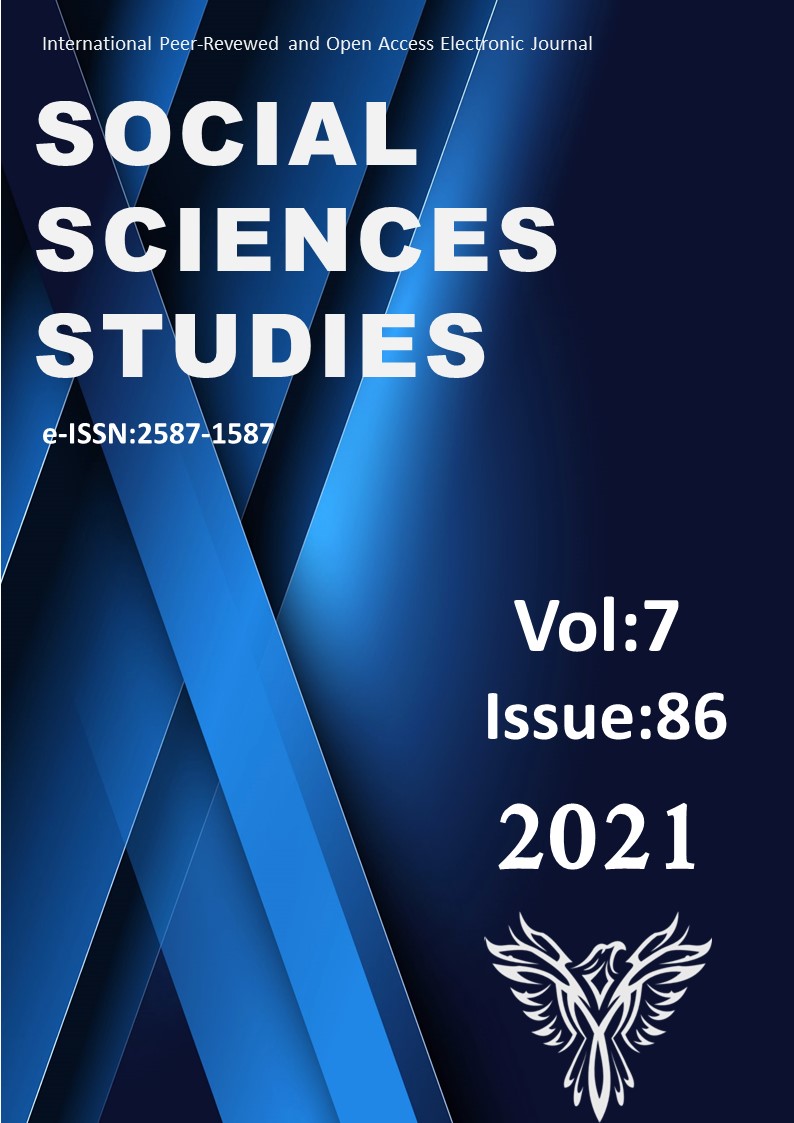TENİS BAŞHAKEMLERİNİN İLETİŞİM KAYGISI DÜZEYLERİ İLE KARAR VERME TARZLARI ARASINDAKİ İLİŞKİNİN İNCELENMESİ
Author :
Abstract
Çalışmanın amacı, tenis başhakemlerinin iletişim kaygısı düzeyleri ile karar verme tarzları arasındaki ilişkinin incelenmesidir. Türkiye Tenis Federasyonu (TTF) resmî web sayfasından elde edilen bilgiye göre ülkemizde tenis branşında 65 başhakem görev yapmaktadır (https://www.ttf.org.tr/). Araştırmanın evreni ve örneklemi aynı olup TTF’ ye bağlı olarak görev yapan 3’ü kadın, 51’ i erkek toplam 54 tenis başhakemi oluşturmaktadır. Araştırma nicel araştırma yöntemlerinden tarama modelinde olup, değişkenler arasında ilişkisel tarama yapılmıştır. Araştırmanın amacına uygun olarak araştırmacı tarafından, kişisel bilgi formu oluşturulmuştur. Bu formda 5 soru ile katılımcıların demografik özelliklerinin belirlenmesi amaçlanmıştır. Katılımcıların iletişim kaygısı düzeyleri, McCroskey (1982) tarafından geliştirilen, Çakmak (2014) tarafından Türkçe’ ye uyarlaması, geçerlik ve güvenirlik çalışması yapılan, İletişim Kaygısı Ölçeği/İKÖ-24 (Personal Report of Communication Apprehension/PRCA-24) kullanılarak ölçülmüştür. Araştırmaya katılan hakemlerin karar verme tarzlarını belirlemek için, Mann vd. (1998) tarafından geliştirilen ve Deniz (2004) tarafından Türkçe’ ye uyarlaması, geçerlik ve güvenirlik çalışması yapılan Melbourne Karar Verme Ölçeği (Melbourne Decision Making Questionary I-II) (MKVÖ I-II) kullanılmıştır. Ölçekler elektronik ortamda hazırlanarak tenis başhakemlerine iletilmiş ve çalışmaya katılımda gönüllülüğün esas olduğu vurgulanmıştır. Elde edilen veriler SPSS 20.0 paket programında analiz edilmiştir. İstatistiksel anlamlılık düzeyi p<0,05 olarak kabul edilmiştir. Sonuç olarak, katılımcıların iletişim kaygı düzeylerinin ve karar verme tarzlarının tüm alt boyutlarda orta düzeyde olduğu, karar vermede öz-saygı düzeylerinin ise yüksek olduğu ortaya çıkmıştır. Ayrıca MKVÖ-II’nin erteleyici alt boyutunun, İKÖ-24’ün %20,4’lük kısmından sorumlu olduğu belirlenmiştir. Katılımcıların İKÖ-24 toplam puanları ile MKVÖ-I arasında anlamlı bir ilişki bulunmazken, MKVÖ-II’ nin bazı alt boyutlarında negatif yönde ve düşük düzeyde anlamlı bir ilişki bulunmuştur. Buna göre İKÖ-24 ölçeğinin -grup ve genel alt boyutları puanları dışındaki- alt boyut puanları arttıkça, MKVÖ-II’ nin alt boyut puanları azalmaktadır.
Keywords
Abstract
The aim of the study is to examine the relationship between the communication apprehension levels of tennis head referees and their decision-making styles. According to the information obtained from the official website of the Turkish Tennis Federation (TTF), 65 head referees work in the tennis branch in our country (https://www.ttf.org.tr/). The universe and sample of the research are the same and it consists of a total of 54 tennis head referees, 3 women and 51 men, working under the TTF. The research is in the screening model, which is one of the quantitative research methods, and correlational scanning was made between the variables. In accordance with the purpose of the research, a personal information form was created by the researcher. In this form, it was aimed to determine the demographic characteristics of the participants with 5 questions. The communication apprehension levels of the participants were measured using the Communication Apprehension Inventory/Personal Report of Communication Apprehension/PRCA-24, which was developed by McCroskey (1982) and adapted into Turkish by Çakmak (2014) and whose validity and reliability studies were performed. To determine the decision-making styles of the referees participating in the research, Mann et al. (1998) and adapted to Turkish by Deniz (2004) and whose validity and reliability studies were conducted, Melbourne Decision Making Scale was used. The scales were prepared electronically and sent to the tennis referees, and it was emphasized that volunteering was essential in participating in the study. The obtained data were analyzed in SPSS 20.0 package program. Statistical significance level was accepted as p<0.05. As a result, it was revealed that the communication apprehension levels and decision-making styles of the participants were moderate in all sub-dimensions, while their self-esteem levels in decision-making were high. In addition, it was determined that the procrastinating sub-dimension of MKVÖ-II was responsible for 20.4% of PRCA-24. While no significant correlation was found between the participants' PRCA-24 total scores and MKVÖ-I, a negative and low-level significant relationship was found in some sub-dimensions of MKVÖ-II. Accordingly, as the sub-dimension scores of the PRCA-24 scale (except for the group and general sub-dimensions) increase, the sub-dimension scores of MKVÖ-II decrease.
Keywords
- Dumangöz, P.D. (2021). “Tenis Başhakemlerinin İletişim Kaygısı Düzeyleri İle Karar Verme Tarzları Arasındaki İlişkinin
- İncelenmesi” International Social Sciences Studies Journal, (e-ISSN:2587-1587) Vol:7, Issue:86; pp:3347-3354 TENİS BAŞHAKEMLERİNİN İLETİŞİM KAYGISI DÜZEYLERİ İLE KARAR VERME TARZLARI ARASINDAKİ İLİŞKİNİN İNCELENMESİ Investigation of the Relationship Between Communication Apprehension Levels and Decision-Making Styles of Tennis Head Referees Dr. Pero Duygu DUMANGÖZ İstanbul Teknik Üniversitesi, Beden Eğitimi Bölümü, İstanbul/TÜRKİYE ORCID ID: https://orcid.org/0000-0002-2827-5538 ÖZET Çalışmanın amacı, tenis başhakemlerinin iletişim kaygısı düzeyleri ile karar verme tarzları arasındaki ilişkinin incelenmesidir. Türkiye Tenis Federasyonu (TTF) resmî web sayfasından elde edilen bilgiye göre ülkemizde tenis branşında 65 başhakem görev yapmaktadır (https://www.ttf.org.tr/). Araştırmanın evreni ve örneklemi aynı olup TTF’ ye bağlı olarak görev yapan 3’ü kadın, 51’ i erkek toplam 54 tenis başhakemi oluşturmaktadır. Araştırma nicel araştırma yöntemlerinden tarama modelinde olup, değişkenler arasında ilişkisel tarama yapılmıştır. Araştırmanın amacına uygun olarak araştırmacı tarafından, kişisel bilgi formu oluşturulmuştur. Bu formda 5 soru ile katılımcıların demografik özelliklerinin belirlenmesi amaçlanmıştır. Katılımcıların iletişim kaygısı düzeyleri, McCroskey (1982) tarafından geliştirilen, Çakmak (2014) tarafından Türkçe’ ye uyarlaması, geçerlik ve güvenirlik çalışması yapılan, İletişim Kaygısı Ölçeği/İKÖ-24 (Personal Report of Communication Apprehension/PRCA-24) kullanılarak ölçülmüştür. Araştırmaya katılan hakemlerin karar verme tarzlarını belirlemek için, Mann vd. (1998) tarafından geliştirilen ve Deniz (2004) tarafından Türkçe’ ye uyarlaması, geçerlik ve güvenirlik çalışması yapılan Melbourne Karar Verme Ölçeği (Melbourne Decision Making Questionary I-II) (MKVÖ I-II) kullanılmıştır. Ölçekler elektronik ortamda hazırlanarak tenis başhakemlerine iletilmiş ve çalışmaya katılımda gönüllülüğün esas olduğu vurgulanmıştır. Elde edilen veriler SPSS 20.0 paket programında analiz edilmiştir. İstatistiksel anlamlılık düzeyi p<0,05 olarak kabul edilmiştir. Sonuç olarak, katılımcıların iletişim kaygı düzeylerinin ve karar verme tarzlarının tüm alt boyutlarda orta düzeyde olduğu, karar vermede öz-saygı düzeylerinin ise yüksek olduğu ortaya çıkmıştır. Ayrıca MKVÖ-II’nin erteleyici alt boyutunun, İKÖ-24’ün %20,4’lük kısmından sorumlu olduğu belirlenmiştir. Katılımcıların İKÖ-24 toplam puanları ile MKVÖ-I arasında anlamlı bir ilişki bulunmazken, MKVÖ-II’ nin bazı alt boyutlarında negatif yönde ve düşük düzeyde anlamlı bir ilişki bulunmuştur. Buna göre İKÖ-24 ölçeğinin -grup ve genel alt boyutları puanları dışındaki- alt boyut puanları arttıkça, MKVÖ-II’ nin alt boyut puanları azalmaktadır. Anahtar Kelimeler: Tenis, Başhakem, İletişim Kaygısı, Karar Verme ABSTRACT





